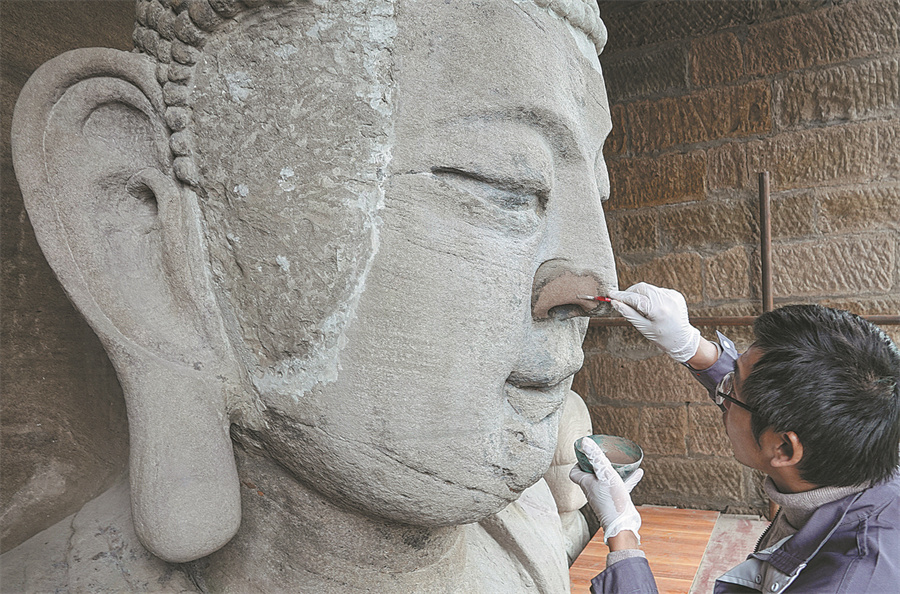Cultural relics to get better protection

Repairs are made to a 14th century sculpture in a grotto near the Yangtze River in Chongqing. [Photo/Xinhua]
Breakthroughs made in research to trace origins of Chinese civilization
The fourth national census of cultural relics in China will be organized this year by the National Cultural Heritage Administration, it was announced at a national conference on cultural relics in Beijing on Thursday.
The effort aims to comprehensively master situations related to the number, distribution, feature and preservation of immovable cultural relics in China, establish a reliable inventory of such relics and provide reference for policymaking to protect them.
The latest census of this scale was held from 2007 to 2011, which provided information on more than 760,000 immovable cultural relics in China.
The conference summarized the performance of the cultural heritage sector in 2022, and announced plans for this year.
Hu Heping, minister of culture and tourism, said that over the past year, heritage administrators have fulfilled their duty under the strong leadership of the Communist Party of China Central Committee, with Xi Jinping, general secretary of the CPC Central Committee, at the core. They have made proactive achievements in their work, bringing fruitful outcomes in archaeological studies as well as the protection, management and display of cultural relics.
For example, breakthroughs have been made in a national research program to trace the origins of Chinese civilization. Besides, 18 major programs related to the culture of the Xia Dynasty (c. 21st century-16th century BC) and the process of civilization in the middle reaches of the Yangtze River have moved forward.
China carried out 254 active archaeological excavations last year, and important findings have been made in Paleolithic archaeology and human origins. Latest studies on the Yinxu site, capital of the late Shang Dynasty (c. 16th century-11th century BC) and jiaguwen, or oracle-bone inscriptions — the oldest-known Chinese writing system — aroused widespread attention.
With Changjiangkou No 2, a Qing Dynasty (1644-1911) wooden shipwreck successfully salvaged out of the water, and the updated regulations overseeing the protection and supervision of underwater artifacts released in 2022, underwater archaeology and cultural heritage protection in China are entering a new stage.
More than 160 programs centering on the protection of cultural relics have been carried out, and they have played a role in rural vitalization, development of border areas and the Belt and Road Initiative.
In 2023, China will continue efforts in many facets of this sector. Hu said the nation will give priority to protecting cultural relics with the utmost care. A number of major protection programs, covering world cultural heritage, grottoes, stone carvings and ancient buildings will be carried out.
Major archaeological programs will continue to be promoted, especially studies of the Erlitou site — widely believed to be the capital of the late period of the Xia Dynasty, the Yinxu site, Nanhai No 1 (a shipwreck off the coast of Guangdong province in the Southern Song period which ran from 1127 to 1279) and Changjiangkou No 2.
The plan calls for improving the monitoring and evaluation system of national archaeological site parks. The plan also points to the need to build more first-rate museums with Chinese characteristics. The collection management system in museums will be upgraded to standardize the ranking and categorization of cultural relics.
Other efforts will include intensifying endeavors to crack down on illegal use or promotion of cultural relics, developing related technologies and deepening cooperation with other countries to carry out key programs.
"We need to allow the achievements of cultural relic protection to better serve economic and social development, enliven cultural heritage, promote the creative transformation and development of such studies, and endeavor to write a new chapter in cultural heritage development," said Hu.
























